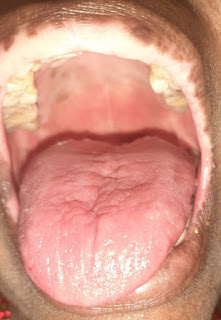A 60 year old female with seizures
This is an online e log book to discuss our patient de-identified health data shared after taking his / her / guardians signed informed consent. Here we discuss our individual patients problems through series of inputs from available global online community of experts with an aim to solve those patients clinical problem with collective current best evident based input.
This E blog also reflects my patient centered online learning portfolio and your valuable inputs on the comment box is welcome.
I have been given this case to solve in an attempt to understand the topic of " patient clinical data analysis" to develop my competency in reading and comprehending clinical data including history, clinical findings, investigations and come up with diagnosis and treatment plan.
60YR OLD FEMALE PATIENT, RESIDENT OF RAMANAPET,FARMER BY OCCUPATION, CAME TO THE OPD,WITH THE CHIEF COMPLAINTS OF :
C/O Involuntary movements of Lt UL and LL ( first episode ) , associated with frothing ,Uprolling of eyes ,Tongue Bite ,Post Ictal Confusion present for 10 minutes .
No seizure activity at presentation but H/O two episodes of seizures occured at their home place and at their local Hospital ( at Ramanapet).
Fever ,which is Sudden in onset and intermittent type since 2 days associated with chills ,rigors and head ache , blurring of vision
Neck pain- dragging type ,diffuse ,present since 2days
H/O fall from bike 2years ago , led to mild abrasions over body and head and associated with fracture of LT wrist joint (as she fell over left side -one side) .
No H/O Cold ,Cough , loss of appetite, Diurnal Variation , Burning Micturition
PAST HISTORY:
Not a K/C/O HTN, DM II , Epilepsy,Asthma ,TB , CAD ,CVD ,Thyroid
PERSONAL HISTORY :
Appetite -Normal
Diet - Mixed
Sleep - adequate
Bowel and bladder movements -Regular
Addictions: Occasional alcoholic ( once every 3days - she consumes 90ml of alcohol )
Betel Nut chewing - Daily for 5-6 times
Allergies : No allergies
GENERAL EXAMINATION:
Patient is conscious ,coherent , cooperative, Moderately Built and Moderately Nourished.
Temp: Afebrile
BP : 130 / 90 mmHg
PR : 87bpm
RR : 20cpm
SPO2 : 96 %
GRBS : 155 mg/dl
Pallor : absent
Icterus : absent
Cyanosis: absent
Clubbing : absent
Lymphadenopathy : absent
Edema : absent
SYSTEMIC EXAMINATION:
CNS : HMF +
RT LT
Tone : UL : N N
LL : N N
Power : UL -5/5 5/5
LL- 5/5 5/5
Reflexes : biceps: 2+ 2+
Triceps : 2+ 2+
Knee: 2+ 2+
Ankle : 1+ 1+
Supinator : 1+ 1+
Babinsky : plantar plantar
Flexion flexion
CVS : S1 S2 + ,no murmurs
RS : BAE Present
P/A : Soft and Non tender
Meningeal signs like : neck stiffness , kerning sign,brudzinsky sign are negative
MRI BRAIN REPORT:
-Acute Infarcts in Right Precentral Gyrus ,Pre motor area ,middle frontal gyrus ,centrum semi ovale ,Corona Radiata
- Mild diffuse Cerebral atrophy
PROVISIONAL DIAGNOSIS:
FOCAL SEIZURES WITH SECONDARY GENERALISATION
MANAGEMENT:
Inj . Levipil 500mg IV /BD in 100 ml NS
Tab . Ecospirin gold AV 75/10 mg PO /OD /HS
Tab . Dolo 650 mg PO/ TID
Inj PCM 1gm IV / SOS ( if temp > 101°F )
Temperature Monitoring 4th Hourly
Vitals Monitoring 6th hourly
SOAP NOTES:
S
No fever spikes
Giddiness +
Tongue Numbness +
O
Patient is Conscious ,Coherent , Cooperative
Temp : Afebrile
BP : 110 /80 mmHg
PR : 76bpm
RR : 18cpm
GRBS :
2AM - 135 mg/dl
8AM - 123 mg/dl
CVS : S1S2 +
RS : BAE +
CNS: NAD
SPO2 : 99%
I /O : 1000/300 ml
A
FOCAL SEIZURES WITH 2° GENERALISATION
(HYPOKALEMIA)
P
IV Fluid 1. NS with OPTINEURON 1amp IV /OD
Inj Levipil 500mg IV /BD
Inj KCL 2 amp in 500 ml NS IV/STAT Over 5 hours
T . Ecospirin AV 75/10 mg PO/OD/HS
T. Dolo 650 mg PO /SOS
Temp Monitoring 4th hrly
Vitals monitoring 6th hrly
DISCUSSION:
FMR = body fat mass (kg) divided by muscle mass (kg)
In men, the risk of Metabolic Syndrome was 2.9-fold higher in the high-FMR group than in the low-FMR group; in women, it was 9.5-fold higher.
A population-based study revealed that the cutoff values of FMR for identifying MS were 0.336 in men and 0.555 in women
The fat-to-muscle ratio is independently and positively associated with metabolic disorders in T2DM. FMR may serve as an optimal method for screening T2DM patients coupled with a high risk of abnormal metabolism, especially in females
Excessive adipose tissue was identified to be accompanied by decreased skeletal muscle quantity, known as SARCOPENIC OBESITY. This combined phenomenon was more closely related to insulin resistance, especially in T2DM patients. Thus, a decline in skeletal muscle mass combined with an increase in body fat may cause a dual metabolic burden, resulting in a higher probability of developing severe metabolic disorders.
Skeletal muscle is one of the main sites of glucose uptake and utilization, decreased muscle mass increases insulin resistance, thereby increasing the risk of T2DM and MS.
Lunar DXA visceral fat could be used to measure visceral fat with results comparable to CT(gold std), relatively rapid, inexpensive with minimal radiation dosage.
https://dmsjournal.biomedcentral.com/articles/10.1186/s13098-021-00748-y
https://www.ncbi.nlm.nih.gov/pmc/articles/PMC6698596/













Comments
Post a Comment